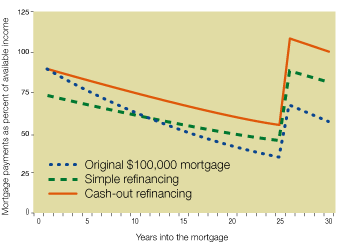Cash-Out Refinancing: Check It Out Carefully
Cash-out refinancing has been a popular option in recent years because it can generate cash today while leaving monthly mortgage payments unchanged. It's not a free lunch, however. The cost of greater financial flexibility today can be a greater burden of repayment later.
Many Refinancing Options
A decline in long-term interest rates has driven a surge in refinancing activity in recent years. Although the number of households refinancing their mortgages declined by more than 50 percent in 2004 compared to 2003, last year still ranks among the busiest "refi" years ever.1
Many refinancing options are available to qualified borrowers. Suppose you just entered into a $100,000 principal amount, fixed 8-percent, amortizing 30-year mortgage.2 The monthly payment on this mortgage would be $733.76. Suppose also that on the next day, 30-year fixed mortgage rates fall to 6 percent because expectations of future inflation have fallen 2 percentage points and all long-term interest rates have been adjusted downward by that amount.
How will you refinance your mortgage? Will you keep the principal amount of the mortgage the same, or will you maintain the same monthly payment, or the same amortization schedule (amount of loan principal paid each month)? Would you like to shorten or extend the term of the mortgage; switch from a fixed to a floating rate or vice versa; take a "hybrid" mortgage with a fixed rate for five years and then convert automatically to floating; pay only interest for a period of time and then begin principal payments; receive a lower interest rate by agreeing not to refinance again for a certain period of time; or pay points (an up-front fee) to receive a lower interest rate? The variety of options can be overwhelming.
For simplicity, we'll consider a choice between only two mortgages: a) simple refinancing-borrow $100,000 at 6 percent for 30 years with standard amortization, reducing your monthly payment to $599.55; or b) cash-out refinancing-borrow $122,385.77 at 6 percent for 30 years with standard amortization, maintaining your monthly payment at $733.76.
Simple refinancing saves you $134.21 each month for as long as you keep the mortgage, while cash-out refinancing allows you to take home $22,385.77 in cash today and keep your monthly payments unchanged. The decision on which route to take isn't an obvious or easy one. In fact, U.S. households were as likely last year to engage in simple refinancing as they were in cash-out refinancing.
Shifting the Burden
To understand the economics of mortgage refinancing when mortgage rates have declined, we need some basic financial tools. The most important is the concept of "duration," a mathematical measure that summarizes both the sensitivity of a fixed-income obligation's fair value to changes in interest rates and, more important for our purposes, the amount of time until half of a debt has been repaid. Duration, thus, is related to the speed at which debt is paid off.
Duration is measured in years and takes into account the fact that interest and principal are paid at various points in time, not just at maturity. A key result from the mathematics of duration is that, for a given fixed-income instrument such as a mortgage, duration increases as interest rates decline and vice versa.
For example, a household that replaces an 8-percent, 30-year, $100,000 fixed-rate mortgage with a 6-percent, 30-year, $100,000 fixed-rate mortgage has accepted greater duration. That is, the refinancing transaction effectively has pushed the real burden of repaying the loan more than a year into the future, on average. The 8-percent mortgage has a duration of 9.6 years, while the 6-percent mortgage has a duration of 10.8 years. In other words, half of the 8-percent mortgage will be paid off after 9.6 years, but it will take 10.8 years to pay off half of the 6-percent mortgage. The key point is that greater duration means a household should expect and plan for greater repayment burdens than previously expected beginning at some future time.
Mortgage Tilt Reflects Duration
To illustrate the complex economic trade-offs involved in choosing between simple refinancing and cash-out refinancing, consider a moderate-income household with a $100,000, 8-percent, 30-year mortgage. After paying all its other expenses (including taxes, food, clothing, transportation, entertainment, housing repairs, etc.), this household has $10,000 available each year ($833.33 per month) to make mortgage payments.3 The $733.76 monthly payment on its 8-percent mortgage represents 88 percent of the amount it can pay without having to cut back on other expense categories.
For purposes of illustration, inflation is expected to be 4 percent each year; so, the household's income and all of its other expenses are expected to rise 4 percent annually. The amount the household can afford to pay on its mortgage also increases by 4 percent each year because its wage income or Social Security payments will increase at about the inflation rate. The economic burden of repaying the fixed-rate mortgage, therefore, declines over time because the level monthly payment effectively is eroded by inflation.
The declining burden over time of repaying the $100,000, 8-percent mortgage is shown by the dotted blue line in the accompanying figure. The downward slope of the repayment-burden schedule is known as the "tilt"of the mortgage. The members of this household expect to retire after 25 years, at which time their income available to make mortgage payments will fall by half. Because inflation has pushed up the household's income over time, the burden of repaying the mortgage even in retirement is manageable-a maximum of only 66 percent of available retirement income is needed to cover mortgage payments during year 26.
Monthly Payment Isn't Everything
Now consider the effects of falling inflation expectations and mortgage rates. The dashed green line in the figure represents a simple mortgage refinancing-that is, the principal remains $100,000 and the monthly payment falls to $599.55. The household's new schedule of repayment burden is flatter than before. That is, the tilt has decreased because the duration has increased. The household faces a lower repayment burden in the early years (through year 10), but a greater repayment burden in the later years compared to the original mortgage. Recall that the household's income is growing at only 2 percent annually rather than 4 percent; so, inflation does not erode the level mortgage payments as rapidly.
The greatest stress over the lifetime of the mortgage now occurs during the household's retirement, when the repayment burden peaks at about 88 percent of available income. This is a result of the mortgage's greater duration, shifting the real burdens of repayment into the future.
Now consider a cash-out refinancing. (See the solid orange line.) The household increases the mortgage principal to $122,385.77, resulting in $22,385.77 of cash to be pocketed now. The monthly payment remains exactly as it was before refinancing ($733.76). The figure shows that the tilt of the new mortgage is less than before while starting at the same level of repayment burden. Thus, the household will face a higher burden of repayment at every subsequent period during the life of the mortgage. In this example, the household's new projected repayment burden peaks in retirement at more than 100 percent of available income. In other words, the cost of the $22,385.77 cash-out refinancing today is the need to cut back other spending later.4
Trickier Than It Looks
The complexities of mortgage refinancing described here do not mean a household with a mortgage should not refinance when interest rates fall. A household would be foolish not to do so if the present value of all the interest it can save is greater than the cost of refinancing. In practice, this usually means that mortgage rates do not need to fall very much to make refinancing worthwhile.
Choosing how to refinance is tricky, however. A lower inflation rate can push down mortgage rates but it also lowers future growth of wage income and Social Security. Lower interest rates increase duration, which means that more of the real burden of repaying the mortgage automatically is shifted into the future.
Unless a household really needs the extra cash today, cash-out refinancing may not be the best choice. Even though the monthly payment may remain the same, the increased mortgage principal amount represents a greater debt burden that must be repaid in the future.
Endnotes
- Data are from the Mortgage Bankers Association. [back to text]
- This mortgage requires you to make monthly payments of $733.76 each month for 30 years, with an option to refinance without penalty at any time. Transaction costs to refinance a mortgage may amount to a few thousand dollars. The monthly payments contain a small amount of principal repayment, or amortization, at the beginning and a progressively larger principal repayment as time passes. The remainder of each monthly payment represents interest on the remaining principal outstanding. [back to text]
- We assume this household does not itemize deductions on its income-tax return; so, the deductibility of mortgage interest is irrelevant to its financial decisions. Less than 28 percent of taxpayers claimed the mortgage interest deduction in 2001 (Internal Revenue Service, 2005), and most of those that do are in relatively high marginal-tax-rate brackets because they have above-median incomes ($42,400 in 2002; U.S. Department of Commerce, 2002). [back to text]
- The household could invest all of the cash-out proceeds to supplement the income needed to meet future mortgage payments, but this strategy is risky unless the investment is guaranteed. Unfortunately, it is impossible to earn a guaranteed return as high as the interest rate on the borrowed money. However, paying off other debt that bears an interest rate higher than 6 percent would be an efficient and risk-free use of cash-out refinancing proceeds. [back to text]
References
Reference text text text
Internal Revenue Service, "Historical Tables and Appendix," Statistics of Income Bulletin, 2005. See www.irs.gov/taxstats/article/0,,id=115033,00.html.
Mortgage Bankers Association, "Weekly Application Survey." See www.mbaa.org/marketdata/.
U.S. Department of Commerce, Bureau of the Census, "Current Population Survey, 2002." See www.census.gov/hhes/www/img/incpov02/fig02.jpg.
Views expressed in Regional Economist are not necessarily those of the St. Louis Fed or Federal Reserve System.
For the latest insights from our economists and other St. Louis Fed experts, visit On the Economy and subscribe.
Email Us



